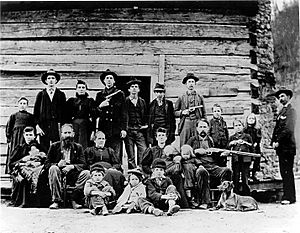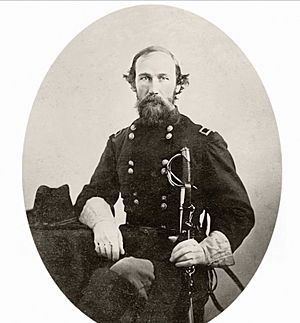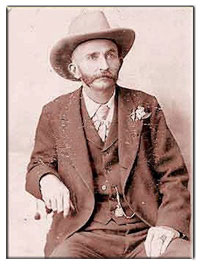Family feuds in the United States
A feud is a long-lasting argument or fight between two families or groups. These fights often involved many people and could become very violent. Sometimes, a small disagreement between two people could grow into a huge conflict involving dozens or even hundreds of people. Many famous feuds in United States history happened in the Old West.
Contents
Famous American Feuds
The Early–Hasley Feud
This family feud happened right after the American Civil War in Bell County, Texas, from 1865 to 1869. The Early and Hasley families continued the disagreements from the war.
John Early supported the government officials who were in charge of Texas after the war. He was part of the Texas Home Guard. He often argued with Drew Hasley, an older local who had strongly supported the Confederacy. When Drew's son, Samuel, came home from the war, he joined the fight against Early, making the feud worse.
Samuel Hasley brought a local outlaw, Jim McRae, into the conflict. John Early then asked for help from federal troops, and they agreed. On July 30, 1869, McRae was ambushed and killed. Soon after, Dr. Calvin Clark, who was friends with Early, was shot and killed in Arkansas. After this, the Hasley supporters broke up, and the feud ended.
The Hatfield–McCoy Feud
The Hatfield–McCoy feud is one of the most famous feuds in U.S. history. It is a well-known story in American folklore. The Hatfields were from West Virginia and led by William Anderson "Devil Anse" Hatfield. The McCoys were from Kentucky and led by Randolph "Ole Ran’l" McCoy.
The feud started on January 7, 1865, when Asa Harmon McCoy was killed. He was a former Union soldier hiding in a cave. A group of Hatfield friends and Confederate soldiers found him and killed him. The conflict flared up again thirteen years later. Two McCoy family members killed a witness who had testified against them in a case about a stray pig.
The feud got even worse when Roseanna McCoy started a relationship with Johnson "Johnse" Hatfield, Devil Anse's son. Roseanna left her family to live with the Hatfields. In 1881, Johnse left Roseanna and married her cousin instead. This made the families even more bitter. In 1882, Ellison Hatfield, Devil Anse's brother, was killed in an election day argument by three of Roseanna's brothers. A mob led by the Hatfields then killed those three brothers while they were being held by the law.
Between 1880 and 1891, more than a dozen family members died because of the feud. It became big news across the country.
The New Years Night Massacre
The feud reached its worst point during the 1888 New Years Night Massacre. Several of the Hatfield group surrounded the McCoy cabin. They shot at the sleeping family and then set the cabin on fire to force Randolph McCoy out. He managed to escape, but two of his children were killed. His wife was beaten and left for dead.
In 1888, Wall Hatfield and eight others were arrested for the New Years Night murders. Seven were sent to life imprisonment, and the eighth, Ellison "Cottontop" Mounts, was executed by hanging. The fighting between the families calmed down after Mounts was hanged. However, trials continued for several years, with the last one being Johnse Hatfield's trial in 1901.
The Lee–Peacock Feud
The Lee–Peacock feud happened in Texas, lasting from 1867 to 1871. It was like a local extension of the American Civil War. About 50 men died in this conflict.
When the Civil War began, Bob Lee joined the Confederate Army. He left his family and home in the care of his father. Near the end of the war, Lee heard that a Union supporter named Lewis Peacock had started a group called "The Union League." This group protected Black people and Union supporters near Lee's home. When Lee and other former Confederate soldiers returned, the area was already tense. Many locals disliked the federal soldiers stationed there during Reconstruction.
The feud got worse when Hugh Hudson, a friend of Peacock, murdered Lee's doctor. Hudson was quickly killed, and other fighters also died. Many were wounded, including Peacock. By the summer of 1868, the fighting was so bad that Peacock asked the federal government for help. They offered a $1,000 reward for Bob Lee's capture. The U.S. Cavalry found and shot Lee on May 24, 1869. However, the fighting continued until Lewis Peacock himself was killed on June 13, 1871.
The Sutton–Taylor Feud
This famous range war started as a problem between the Taylor family and local lawman William E. Sutton. Sutton was a former Confederate soldier who had moved to DeWitt County, Texas, to raise cattle. The feud lasted ten years and caused at least 35 deaths. It is called the longest and bloodiest feud in Texas history. The Texas State Police, the Texas Rangers, and the outlaw John Wesley Hardin eventually got involved.
Sutton became a deputy sheriff. On March 25, 1868, he shot and killed Charley Taylor, a relative of the Taylors, while trying to arrest him for horse theft. On Christmas Eve, Sutton killed Buck Taylor and Dick Chisholm in a saloon after an argument about horses. On August 23, 1869, the Sutton group was suspected of ambushing and killing Jack Hays Taylor.
In July 1870, Sutton joined the State Police Force. This force was supposed to enforce federal "Reconstruction" policies. However, they often operated freely and sometimes killed wanted suspects instead of arresting them.
On August 26, 1870, the Suttons were supposedly sent to arrest Henry and William Kelly, who were related to Pitkin Taylor, for a minor charge. But instead of arresting them, the Suttons shot the Kellys. Because of how he handled this, Captain Jack Helm, who was in charge, was dismissed from the State Police Force.
John Wesley Hardin Joins the Feud
In early 1872, the outlaw John Wesley Hardin joined his cousin, Mannen Clements, in Gonzales County, Texas. Clements and his brothers were involved in cattle rustling for friends of the Taylor family.
On May 15, 1873, Sutton family friends Jim Cox and Jake Christman were killed by the Taylor group during a gunfight. Hardin later said there were rumors he led that fight, but he wouldn't confirm it.
Two days later, on May 17, 1873, Hardin killed Dewitt County deputy sheriff J.B. Morgan in a gunfight. Morgan worked for Jack Helm, who was now sheriff. Later that same day, Hardin helped kill Sheriff Helm in Albuquerque, Texas. Hardin, Helm, and Sam McCracken Jr. were talking outside a blacksmith shop. Helm was unarmed. James Taylor tried to shoot Helm from behind, but his gun misfired. When Helm turned, Taylor fired again, hitting Helm in the chest. Helm rushed Taylor, but Hardin shot Helm's arm with a shotgun. As Helm tried to run into the shop, Hardin held townspeople at gunpoint while Taylor shot Helm five more times. Hardin and Taylor then rode away, bragging about what they had done.
The next night, Hardin and other Taylor supporters surrounded the ranch house of Joe Tumlinson, a Sutton ally. They agreed to a truce and signed a peace treaty in Clinton, Texas. However, violence broke out again within a year.
The feud reached its peak when Jim and his cousin Bill Taylor shot Billy Sutton and his friend, Gabriel Slaughter. This happened on a steamboat platform in Indianola, Texas, on March 11, 1874. Billy Sutton had been planning to leave the area for good because he was tired of the feud. In return, the Sutton group caught and hanged three of the Taylor group on June 22, 1874. After this, the fighting continued, but less often. Jim Taylor was killed on January 1, 1875. On November 17, 1875, Reuben H. Brown, the new leader of the Suttons, was shot in a saloon by Hardin. This was Hardin's last known action in the feud.
In October 1876, after more violence, Texas Ranger Captain Jesse Lee Hall led a force into Cuero, Texas, to end the feud for good. By January 1877, he and his team had stopped the conflict.
The Horrell–Higgins Feud
The Horrell and Higgins families had lived in Lampasas County, Texas, for many years before the Civil War. They got along well for over ten years. However, by the early 1870s, the five Horrell brothers (Mart, Tom, Merritt, Ben, and Sam) were involved in many illegal activities. In January 1873, Sheriff Shadrick T. Denson tried to arrest two brothers, Wash and Mark Short, who were friends of the Horrell family. The Horrell brothers interfered, leading to a gunfight where Sheriff Denson was killed. A judge asked Texas Governor Edmund J. Davis for help. The Texas State Police sent officers to the area to keep order.
On March 14, 1873, state officers arrested Bill Bowen, a brother-in-law of the Horrell brothers, for carrying a gun. The officers then went into Jerry Scott's Saloon with Bowen. After an argument with the Horrell brothers inside the saloon, a gunfight started. Four officers were killed, including Captain Williams. Williams managed to shoot and badly wound Mart Horrell. His brother, Tom Horrell, was also wounded. After the gunfight, more state police were sent. Mart Horrell and three friends were arrested and taken to jail. However, a large group of Horrell family friends broke into the jail and freed them.
The brothers fled to Lincoln County, New Mexico. Later that year, Ben Horrell was killed after he murdered a local law enforcement officer. In early February 1874, the brothers returned to Lampasas, but they were no longer welcome. Soon after their return, a local rancher, John "Pink" Higgins, accused the Horrell brothers of stealing some of his cattle. The brothers were arrested but quickly found innocent. Although things were tense, neither side took action at that time.
The feud quickly got worse. On January 22, 1877, John Higgins shot and killed Merritt Horrell in a gunfight at a saloon in Lampasas. The three remaining Horrell brothers vowed revenge. On March 26, 1877, Tom and Mart Horrell were shot and wounded in an ambush, but both survived. John Higgins and Bob Mitchell were arrested for this but later found innocent.
Shootout at the Lampasas Town Square
On June 7, 1877, John Higgins rode into Lampasas with his brother-in-law, Bob Mitchell, Mitchell's brother Frank, a friend named Bill Wren, and another brother-in-law, Ben Terry. The Horrell brothers and several friends were already in town, gathered at the town square. It's not known who shot first, but it's believed someone from the Horrell group opened fire on Higgins's group. When the gunfight ended, Bill Wren was wounded, Frank Mitchell was killed, and Horrell group members Buck Waltrup and Carson Graham were killed.
All three Horrell brothers were arrested. Texas Ranger Major John B. Jones helped mediate between the remaining members of the two groups. Less than a year later, Mart and Tom Horrell were arrested for armed robbery and murder. While they were in jail, vigilantes broke in and shot and killed them both. Sam was the only Horrell brother left. He moved his family to Oregon in 1882, which ended the feud.
The Lincoln County Feud
The Lincoln County Feud happened in the Harts Creek community of Lincoln and Logan counties, West Virginia, between 1878 and 1890. It started as a personal argument between Paris Brumfield and Canaan Adkins. The feud grew into a bitter war between local timber owners and business people, including Allen Brumfield, John W. Runyon, and Benjamin Adams. The feud caused at least four deaths, many injuries, and fights. It was covered by newspapers across the country. Many key people involved either died or moved away.
The Earp–Clanton Feud
The Earp vendetta ride happened because the Earp brothers were attacked in December 1881 and March 1882. These attacks were revenge for their involvement in the Gunfight at the O.K. Corral in Tombstone, Arizona.
The O.K. Corral Gunfight
The famous gunfight happened on October 26, 1881. It was the peak of the Earp–Clanton family feud, which had been building since the summer of 1880. Tensions between the Earps and the Clantons and McLaurys grew throughout 1881, leading to this historic gunfight. At the O.K. Corral, three Earp brothers—Wyatt, Morgan, and Virgil—along with Doc Holliday, killed Billy Clanton, Frank McLaury, and Tom McLaury. The Clanton and McLaury families were connected to the "Outlaw Cowboys." This was a group of outlaw families and friends living in Cochise and Pima counties.
The Earp Vendetta Ride
The Earp Vendetta ride was a hunt for the "Outlaw Cowboys" whom Wyatt Earp blamed for hurting his brother Virgil and killing his brother Morgan. Virgil was the police chief of Tombstone, Arizona and a Deputy U.S. Marshal. Morgan was also an assistant U.S. Marshal. When some suspects in the attacks were set free by the court, Wyatt Earp decided he couldn't rely on the law. He took matters into his own hands.
On March 20, 1882, Wyatt Earp, who was now a United States Marshal, formed a federal group called a posse. They searched Cochise and Pima counties to hunt down and kill the men he believed were guilty. Wyatt and Warren Earp, Doc Holliday, John "Texas Jack" Vermillion, Dan Tipton, Charlie Smith, Fred Dodge, Johnny Green, and Lou Cooley were part of this posse.
The killings began on March 22, 1882, when Frank Stilwell was shot. Stilwell and several Outlaw Cowboys, including Ike Clanton, were waiting to ambush the Earp group at the Tucson rail station. The Earp group was taking the still injured Virgil Earp and his wife to safety out of the dangerous Arizona Territory.
Cochise County Sheriff Johnny Behan, a rival of Wyatt Earp, then formed his own posse. He made several outlaws deputies, including Johnny Ringo and Phineas Clanton. This group of about 20 men rode after the federal posse.
Carrying federal arrest warrants for the assassins, the federal posse killed four men. The vendetta ride ended with the killing of "Curly Bill" Brocius and Johnny Ringo on April 15, 1882. The Earps and their friends then quickly left Arizona Territory and headed for the New Mexico Territory, leaving the feuding behind.
The Brooks–McFarland Feud
This family feud happened between 1896 and 1902 in the Creek Nation of the old Indian Territory (now Oklahoma). It started when Thomas Brooks was killed on August 24, 1896. Brooks died during a robbery that was supposed to include some members of the McFarland family. The Brooks family blamed the McFarlands for the death. A series of fights between the two families followed.
The feud ended with a big shootout in Spokogee (now Dustin), Oklahoma, on September 22, 1902. During the gunfight, the family leader, Willis Brooks, and his son, Clifton, were killed. George Riddle, a McFarland family friend, also died. John Brooks, Clifton's brother, was badly wounded. Survivors Jim and Joe McFarland, Alonzo Riddle (George's brother), and the wounded John Brooks were arrested for murder. However, they were all quickly released on bail.
The feud officially ended on October 10, 1902, when Jim McFarland was ambushed and killed near his home. It's possible Sam Baker, a Brooks ally, was responsible.
John Brooks left the area after he recovered from his wounds. Henry Brooks, the remaining brother, left soon after serving time for horse theft. He died violently in a shootout with Alabama police in 1911. Sam Baker was killed on October 7, 1911, by the son of a shopkeeper he had argued with. Willis Brooks's widow, "Old Jenny" Brooks, died on March 29, 1924, at 98 years old. She was said to be proud that all her sons had "died like men, with their boots on."
The McFarland family members were found innocent of any wrongdoing after the fight and continued to live in the Dustin area.
The Reese–Townsend Feud
The Reese–Townsend conflict, also called the Colorado County Feud, was a politically motivated feud. It happened in the last days of the Old West, mainly in Columbus, Texas, but also in other parts of Colorado County. The feud lasted from 1898 to 1907.
It started because of a local election for sheriff. The current Sheriff Sam Reese was running against Larkin Hope, a former deputy. Mark Townsend, a former U.S. senator, was a powerful person who had influenced many past sheriff elections. He stopped supporting Reese and instead supported Hope. This caused tension between Reese's supporters and Townsend's group. When Hope was killed in downtown Columbus before the election, suspicion immediately fell on Reese's friends. Townsend's chosen candidate, Will Burford, won the election.
On March 16, 1899, Reese was killed in a gunfight that he started with Townsend's friends. Reese's family vowed revenge. From May 17, 1899, to May 17, 1907, five more gunfights happened in the area. Dick Reese (Sam's brother), Arthur Burford, Hiram Clements, and Jim Coleman all died in the violence. The famous Texas Ranger Captain Bill McDonald, along with officer James Brooks and others, were sent to the area to restore order and end the fighting.
Other Notable U.S. Feuds
- Barber–Mizell feud
- Boyce–Sneed Feud
- Greene-Jones War
- French-Eversole Feud
- Jones-Liddell feud
- Rowan County War
- Coates-Frost feud
- Tutt-Everett War
- Flynn-Doran Feud





